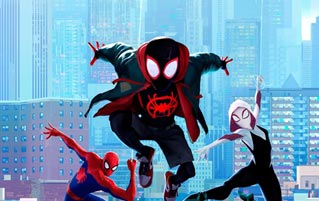4 Bits Of Buried Symbolism In Movies

Movies are usually pretty upfront about their themes, like "Greed is bad" or "The Joker is, like, because society, man." But sometimes they can be far more clever, so that it's not until you sleep on them for a while that you realize what they were trying to say. Or even better, you can just read this instead. Learn how ...
Spider-Man: Into The Spider-Verse Had A Secret Hidden In Its Animation
Spider-Man: Into The Spider-Verse won the 2019 Oscar for being that year's movie Twitter users would riot over if it didn't win, and its compelling animation style received particular praise. For those shameful few readers who haven't seen it, it's about Miles Morales taking up the Spider-Man mantle while encountering other, more experienced spider-folk from parallel universes.
Our knowledge of animation essentially peaked at making stick figures dance in the corners of our math textbooks, but we can tell you that most of it is made at 24 frames per second. Creating a different image for each frame, which is typical today, is called animating "on ones," while holding the same image for two frames is doing it "on twos." If you grew up watching the kind of Spider-Man cartoons that were made in sweatshops to cram around breakfast cereal commercials, those were often made cheaply on threes or fours, hence the stilted look and long shots of static characters talking through their masks.
Don't Miss
Spider-Verse, however, used a mix of twos and ones to give the animation a "crunchy" feel, which we believe is a technical term for "not looking like crap, but still making you nostalgic for the days where you ate Captain Crunch in front of cartoons all morning." But the real clever bit is when it uses different speeds to suggest Miles' inexperience. For example, one scene sees Miles and Peter Parker swinging together to escape some goons. Peter is animated on ones to make his actions look natural and refined, while Miles is animated on twos to make him look like a laggy NPC. After all, he's still figuring out his powers.
Later, as Miles begins to adjust to his spideyness, his animation smooths out accordingly. Presumably they'll crank it up even further for the sequel, and then just keep pumping movies out until Miles is no longer visible to the human eye and becomes more of an existential Spider-Man. You know, a Spider-Zeitgeist or something.
Related: 6 Movie Details You Never Noticed That Reveal The Whole Plot
In Eternal Sunshine Of The Spotless Mind, Clementine's Hair Represents The Stages Of The Relationship
Filming Eternal Sunshine Of The Spotless Mind posed a few challenges, like which gummy worm flavors to model Kate Winslet's wigs after. But as the fine folks at Screen Prism observed, there were good reasons for all the switches between Chill Cherry and Baha Blueberry Blast.
Jim Carrey, who plays against type as someone who occasionally shuts up, learns that Winslet's Clementine has moved on from their relationship in the quickest and most Charlie-Kaufman-esque way: expunging him from her memory with science. So he undergoes the same process, during which we get a time-bending look back at their relationship. Throughout the story, observing Clementine's hair color is the best way to tell when each moment happened. For example, her hair is green when they first meet.

Green is the color of springtime. It's renewal, growth, enjoying new life by frolicking among the daffodils. Then, when they're all "hashtag relationship goals," her hair is a summer red. This is the passionate height of their love affair.

In the autumn of their relationship, the red becomes orange, and Clementine is putting less care into maintaining it. This is what we writers call ... uh ... a hyperbole?

Finally, with their relationship dead and erased, Clementine's hair is the cold blue of winter. But there's also a hint of green, foreshadowing how they're going to reconnect and give it another go (even though they're frankly terrible for each other).

Anyway, if you enjoyed this analysis, we should get around to figuring out all of Synecdoche, New York by 2027 or so.
Related: 6 Movie Plot Holes You Never Noticed Thanks To Editing
The Wire Really, Really Liked Chess
In an early episode of The Wire, chess is used to explain the hierarchy of the drug world, the game having been a go-to instrument for explaining power dynamics since about the 6th century.

D'Angelo teaches Bodie and Wallace that the king is the big boss who can move in whatever direction he damn well wants and has other pieces to do the heavy lifting for him. The queen is the flexible second in command who gets things done, and the rooks are the muscle who move drug stashes around. Then there are the pawns, the vulnerable frontline soldiers with the least power. Most of them get slaughtered, and while a smart or lucky one can get promoted, they can never become the king. Knights and bishops aren't covered, because it's not a perfect analogy.
When Season 4 rolls around, Bodie has realized that despite some promotions, he's always just going to be a pawn in a rigged game. A few episodes and a story arc being wound down later, he's attacked by two enemy enforcers. They approach him in a straight line, like rooks, while he stands his ground and fires at them diagonally, the only method of attack that pawns have. But it's all just a distraction for a third attacker to use a sneaky L-shaped move to get behind Bodie and kill him.
Clearly, this is all symbolic of the fact if you're going to explain the rules of a board game to someone, you shouldn't stop halfway through and then be all "Oh sorry, forgot that part!" when they get themselves killed in it.
Related: 5 Huge Twists You Never Noticed Were Spoiled From The Start
The Matrix Was Full Of Trans Symbolism
Identity and transformation are big themes in The Matrix, which in retrospect makes sense, as both directors have since come out as transgender. Lilly Wachowski even invited the world to look back on their work through a "lens of transness." So hey, let's do that.
In The Matrix, the majority of humans are trapped within an artificial construct (of gender and bad '90s clothing), and Keanu Reeves is stuck living a double life within it. He pretends to be the boring Thomas Anderson by day, but by night he's chosen the identity of Neo, a hacker who's searching for something. He doesn't know just what that is, but he knows something isn't right, like when your aunt puts raisins in the potato salad. That's gender dysphoria.
In the iconic red pill scene, Neo is given a choice to either know the truth by taking the red pill or go back to living the raisin-potato-salad life by taking the blue pill. Morpheus behaves like a therapist counseling Neo through his transition, which is why some in the trans community use the red pill metaphor to represent hormone therapy. Once unplugged, Neo starts to become his true self -- and also learns super karate, because allegories are always better with martial arts.
The unplugged characters choose their own names, let their past identities die, and generally wear androgynous clothing and hairstyles. They also face danger from the Matrix's agents, who are trying to enforce the simulation's binary rules with violence. Oh, and the original script called for the character Switch to be played by both a man and a woman, presenting as male on the Nebuchadnezzar but female within the Matrix. This was cut because Warner Bros. executives worried it would be "confusing to the mainstream movie going audience," which you can take as you will.

Anyway, even if you think this is a stretch, you can still enjoy how it pisses off the reactionaries who have tried to co-opt the red pill metaphor. Then, of course, there are the sequels, where ... well ... uh ... there are the sequels.
For more, check out The Mind-Blowing Hidden Meaning Of 'Back To The Future':
Follow us on Facebook. If you like jokes and stuff.